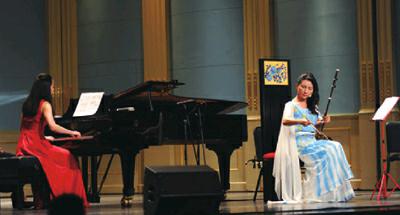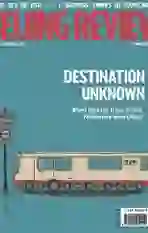In Harmony
2015-11-05ByJiJing
By+Ji+Jing
The erhu and the piano, two musical instruments originating from the East and West, nonetheless enjoyed a close dialogue in the Beijing Concert Hall on the night of September 21. The concert was jointly performed by Chinese erhu musician Ma Xiaohui and 20-year-old German-born Chinese pianist Wan Jieni.
The musical compositions played during the concert include well-known Chinese works such as Moon Reflected in the Two Springs by street erhu player Hua Yanjun (1893-1950), Western classics by German composers Johann Sebastian Bach and Johannes Brahms and Mas original compositions such as The Story of Two Strings. Selected poems by renowned Tang Dynasty (618-907) poet Li Bai and German poet Johann Wolfgang Von Goethe were recited by the two musicians during the concert, creating another rendezvous between Chinese and Western cultures.
It was notable that on this occasion, seasoned musician Ma collaborated with a musician from the post-90s generation. Ma told Beijing Review that this represented a conscious decision on her part.
“I feel it to be my responsibility to enable more people to fall in love with the erhu. My principal target audience is young Chinese people as they represent the future of the world. If they dont know their own culture, it would be sad,” said Ma.
“Having a post-90s musician perform to-gether with me will draw more young people to the concert,” Ma reasoned.
Wan, who received musical training in both China and Germany and attended the University of Music and Performing Arts in Munich, felt honored to be afforded the opportunity to cooperate with Ma: “This is the first time that I have cooperated with an erhu musician. Its both exciting and challenging.”
As a pianist, Wan was predominantly exposed to Western pieces, so she initially was unfamiliar with many of the Chinese works which were to be played during the concert. Thus Ma explained to her the differences between Western and Chinese music and instructed her as to how to deal with particularly tricky sections.
Musical synergy
This form of erhu-piano dialogue first originated in 1996 when German pianist Tim Ovens, awed after taking in one of Mas performances in Shanghai, expressed his wish to collaborate.
“Previously, it was common for the two musical instruments to be played together in the 1960s and 1970s, though piano was in a position of accompaniment,” said Ma.
“Dialogue implies that the two instruments are on an equal footing and are able to interact with each other,” Ma told Beijing Review.
The two artists worked together non-stop for nine days and nights to adapt and rehearse two archetypical erhu compositions Listening to the Pines and When the Grapes Are Ripe, before recording their version of the aforementioned songs and shooting a music video.
However, replicating erhu works on a piano proved no easy task. Ma had to explain to the German musician the peculiar characteristics and intricacies of Chinese music.
When he returned home to Germany, Ovens brought back the recordings and video he and Ma had made. They were warmly received by local musicians and Ovens later invited Ma to co-host salon concerts in Germany.
Ma formally launched the erhu-piano dialogue project in 2003. Over the past decade or so, she has dedicated herself toward introducing the instrument to other countries and carried out “dialogues” with over 50 kinds of instruments and more than 100 musicians from around the world.
Taking notes
Possessing a profound love for the instrument, Ma wants a greater number of people to be able to appreciate its beauty.
“The two-string erhu sounds very much like human voice as we also have two vocal cords. The instrument is able to evoke a certain tragic beauty, which is quite moving,” said Ma.
The erhu has its origins in the Tang Dynasty and had developed slowly up until the early 20th century, when Chinese composer, erhu player and music educator Liu Tianhua (1895-1932) revolutionized how the instrument was played, based on Western musical theories and performance techniques conventionally associated with the violin. Since then, the erhu has developed from a folk musical instrument to perhaps the most representative example of Chinese musical instruments used today.
Nevertheless, compared with Western instruments such as the piano and the violin, the erhu is less well known around the world. Even in China, young children often take up piano and violin as extracurricular pursuits rather than opting for the traditional instrument. This is why Ma feels it is so urgent to promote the erhu among the countrys younger generation as well as people overseas.
In addition to taking part in music festivals and concerts in Europe and Japan, Ma has delivered a series of combined lectures and concerts in prestigious American higher-learning institutions such as the University of Chicago and Notre Dame.
“With the rapid development of the Chinese economy, a lot of people in the world have been drawn to aspects of Chinese culture such as tea and calligraphy, although few of them know much about Chinese music,” Ma said.
What Ma wishes to promulgate is not simply the instruments melodies but also, in a broader sense, the distinct charms of traditional Chinese culture.
In order to better appeal to a global audience, Mas style has assimilated a diversity of genres including jazz and African American spirituals. To study these genres, she has also spent time in a dozen or so American universities. Her purpose in doing so is clear: She wishes to use a language familiar to the audience to convey the individual allure of her culture.
“Without a sufficient understanding of foreign countries cultures, one would not be able to play their musical works,” she said.
Ma said her purpose is not to prove that the erhu can also play Western works but to put a new spin on Western classics.
She compares herself to a gypsy lady, traveling around the world with her trusty erhu.
Mas performance has won raptorous ap- plause from overseas audiences. She even found her Mr. Right among her listeners—Timothy A. Kelly, an American psychologist who called himself a big fan.
Kelly first listened to Ma playing on the Los Angeles leg of one of the musicians American tours.
“Ive never seen an erhu before. But when she played, she actually played the piece that she wrote called Spirit of My Erhu. As she played, those notes struck something deeper and deeper and deeper so I started crying. I even noticed there were some other people with some tears too. I had never seen or experienced music that powerful,” Kelly recalled.
“[The] erhu may be a symbol of Chinese people. When you look at it first it looks interesting and then you realize its much more powerful and capable than it seems,” Kelly added.
When the musically oriented psychologist met with the very cerebral musician, the two joined forces to come up with the novel idea of healing psychological wounds with erhu music.
Kelly moved to China to be with Ma several years ago and now works with an international hospital in Shanghai as a psychologist. The couple has recently staged a series of lectureconcerts on the psychology of how music can heal the soul both in the United States and China. Thus far, feedback has been positive.
“Shes actually very focused on the needs of others: her parents, her staff, people in her life. The more I get to know her, the more I become her No. 1 fan,” said Kelly.
